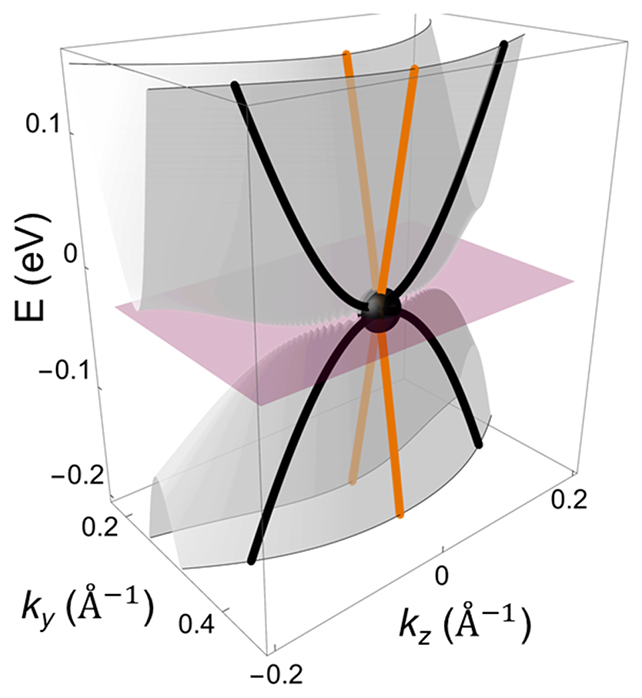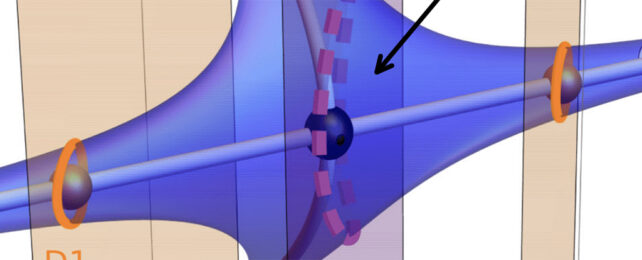Scientists have made a satisfying and intriguing physics discovery some 16 years after it was first predicted to be a possibility: a quasiparticle (a group of particles behaving as one) that only has an effective mass when moving in one direction.
In physics, mass generally refers to a property of particles that relates to things like their energy and resistance to movement. Yet not all mass is built the same – some describes the energy of a particle at rest, for example, while mass may also take into account the energy of a particle's motion.
In this case, the effective mass describes the quasiparticle's response to forces, which varies depending on whether the movement through the material is up and down, or back and forth.
Whereas regular quasiparticles have the same mass no matter what their direction of travel, the semi-Dirac fermion (to give it its technical name) being studied here doesn't seem to play by the normal rules.
It's a discovery that could make a fundamental difference in fields such as quantum physics and electronic sensors.
The new quasiparticle was discovered by an international team of scientists inside a ZrSiS semi-metal crystal, cooled down to -452 degrees Fahrenheit (or -269 degrees Celsius) – an extreme set of conditions for an extremely rare quasiparticle.

Particles can generally be described as bosons or fermions, depending on a measure of a property called spin. Dirac fermions – in both typical and quasiparticle form – have properties that come in opposing particle and antiparticle forms.
This semi-Dirac fermion detailed in the new study is a strange beast of a thing that only existed in theory up until now, operating under very different guidelines of energy in perpendicular directions.
"This was totally unexpected," says condensed matter physicist Yinming Shao, from Pennsylvania State University. "We weren't even looking for a semi-Dirac fermion when we started working with this material, but we were seeing signatures we didn't understand."
"It turns out we had made the first observation of these wild quasiparticles that sometimes move like they have mass and sometimes move like they have none."
The researchers were using a scientific analysis method known as magneto-optical spectroscopy when they made the discovery. It's where materials are studied via the infrared light reflections they give off, under the influence of a strong magnetic field.
And we do mean strong: some 900,000 times stronger than the Earth's magnetic field, courtesy of the National High Magnetic Field Laboratory in Florida. These are the exotic conditions scientists use to study the rarest interactions at the smallest scales.
From there, the semi-Dirac fermion activity was observed and identified, with the help of some numerical modeling: being massless in one direction (with all its energy described by its movement), but having effective mass in another. Fortunately for the non-physicists, the researchers provide an analogy.
"Imagine the particle is a tiny train confined to a network of tracks, which are the material's underlying electronic structure," says Shao.
"Now, at certain points the tracks intersect, so our particle train is moving along its fast track, at light speed, but then it hits an intersection and needs to switch to a perpendicular track.
"Suddenly, it experiences resistance, it has mass. The particles are either all energy or have mass depending on the direction of their movement along the material's 'tracks'."
It's a notable moment in physics, including for those who first hypothesized the phenomena back in 2008. There's still a lot to explore here though – including figuring out how to extract single layers from the multi-layered ZrSiS crystal – before we can start thinking about its full implications and any practical uses.
"The most thrilling part of this experiment is that the data cannot be fully explained yet," says Shao.
"There are many unsolved mysteries in what we observed, so that is what we are working to understand."
The research has been published in Physical Review X.
